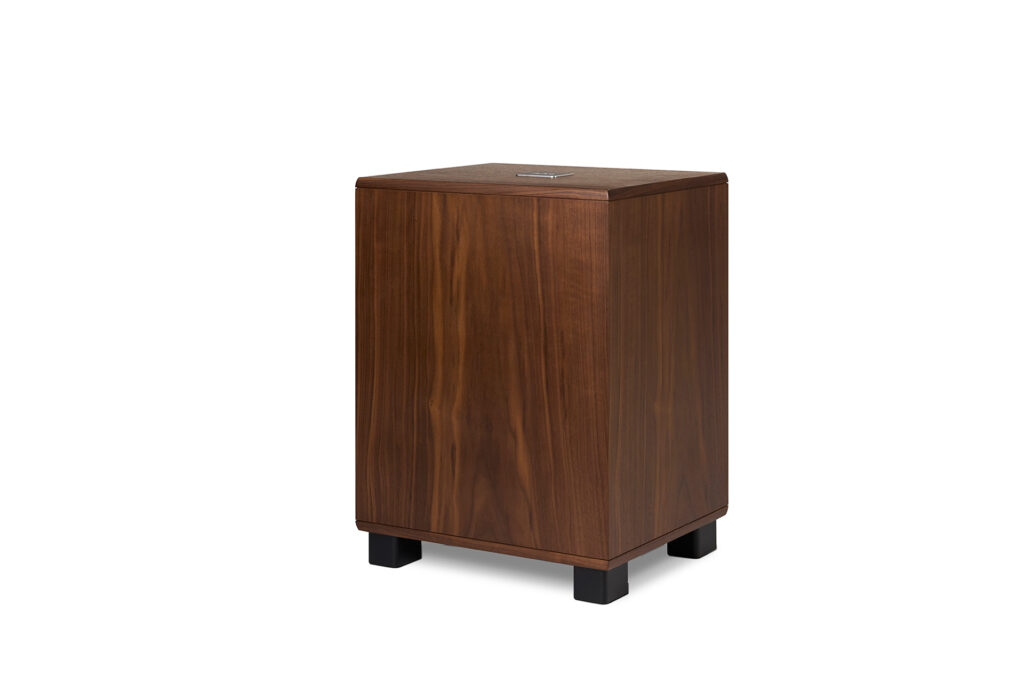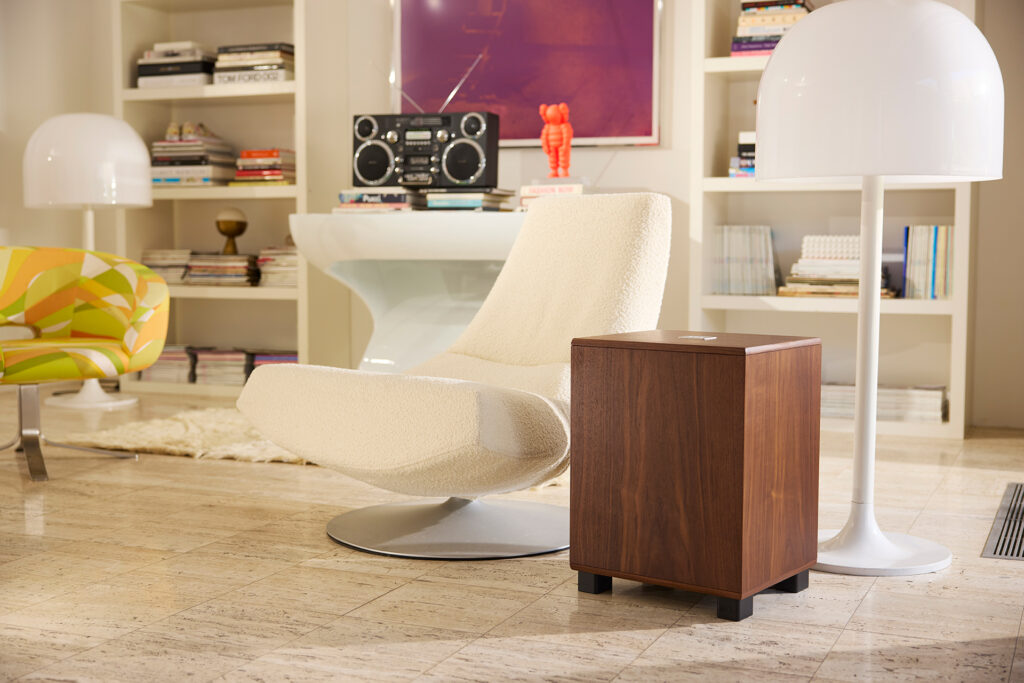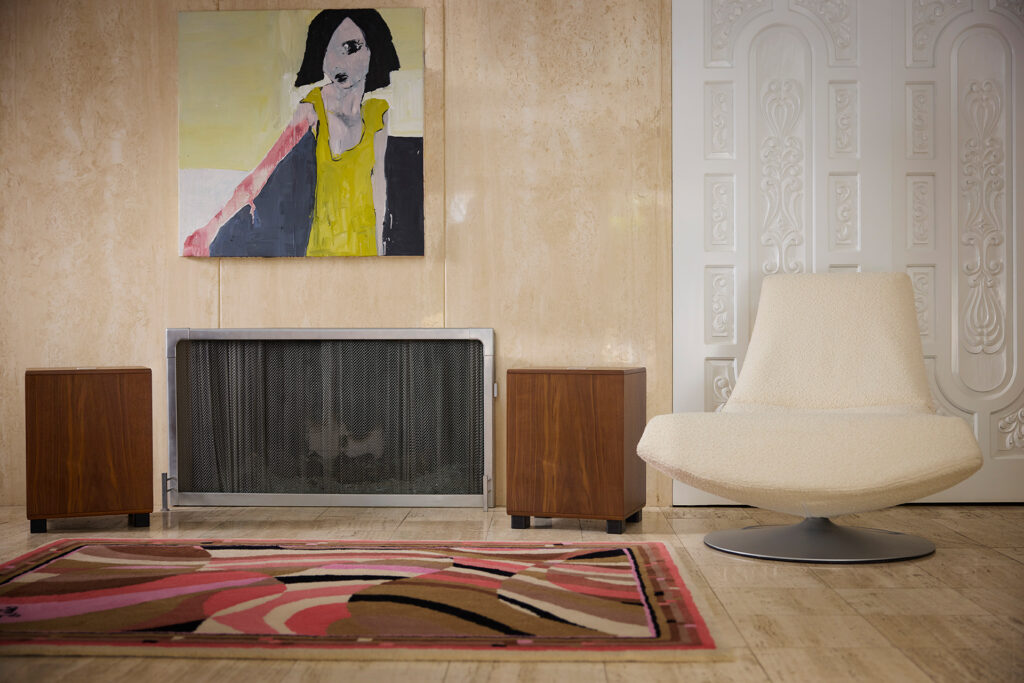REL is a well-known name in the world of audiophile subwoofers with a reputation for making musical subwoofers. The feature that sets REL apart from other manufacturers is their unique connection method, which utilizes the amplifier outputs. Most of the REL subwoofers I see at shows and stores are glossy, modern-appearing units, not the REL Classic series. The Classic series features a beautiful dark walnut veneer with a matte finish that not surprisingly is reminiscent of the speakers I grew up with. REL launched its Classic series with their Classic 98 subwoofer, which featured a 10-inch, downward-firing driver powered by a 300-watt amplifier. The Classic 98 was well-received and often paired with classic speakers, as they made for a good match both sonically and visually. There was a demand for an even bigger and more powerful version that would pair better with speakers that already have decent low-end extension, but not quite enough to satisfy their owners. The Classic 99 was introduced to fill this need.

Like the smaller Classic 98, the Classic 99 is designed to complement classic loudspeakers from our audiophile past, both visually and sonically. The Classic line of subwoofers uses modern design and technology, but with the aim to create a sonic signature that blends better with speakers of the past. This balancing act is discussed more below, but the effort is immediately evident upon first sight. The dark matte walnut finish looks right in place next to the JBL or English monitors from the ‘80s and ‘90s. This makes sense to me. If you are placing this subwoofer in a room with older monitors, the incongruity of a more modern finish would stick out visually.
When I first learned about the design goals for the Classic series, I was curious as to how REL would pull it off. The aesthetic aspect is simple enough. There are still great cabinet makers that can produce a variety of wood finishes that evoke the era of bygone days. Sonic was the area of concern for me. While I have enjoyed many great audiophile speaker setups from decades ago, my early experiences with subwoofers were less impressive.
What Makes the REL Classic 99 Special?
- REL’s unique high-level connectivity has to come first. REL is unique in providing a three-lead cable that connects to your amplifier on one end and utilizes a Neutrik connector on the subwoofer end. The theory behind this is that the subwoofer is being driven by the same signal, with the same sonic signature that is driving your speakers. The supplied cable is 10 meters long, which should suffice for most installations. Once the signal is inside the subwoofer and reduced in level, it is passed through REL’s proprietary “Natural RollOff” crossover circuit.
- The REL Classic 99 has plenty of connectivity options. If the high-level input is not for you, there are both low-level and .1/LFE inputs via RCA connectors. The .1/LFE input bypasses the crossover circuit and has its own level control. The low-level RCA and high-level inputs share a level control, as well as an adjustable crossover. There is also a two-position phase switch to round out the controls. REL was kind enough to supply their Air Ship II ($399) wireless transmission system, which takes high- or low-level inputs (both balanced and single-ended) and uses a 5.8 GHz signal to transmit to a receiver up to 60 feet away.
- The 12-inch paper cone driver is a lot better than you might think. Those of you who follow speaker technology may be wondering how a paper cone driver is a feature in today’s world of exotic speaker driver materials. It is. REL made the conscious choice to develop a custom, hot-pressed paper driver to better emulate the sonic characteristics of classic speakers. The cone is part of a long-throw, downward-firing, closed-box system that has a -6 dB point of 24Hz. REL is, however, adopting new technology where appropriate, such as the 450-watt Class-D amplifier with their analog “PerfectFilter” technology.
- The REL cabinet is high-end classic in aesthetics, with some discreet modern touches. As noted above, the cabinet’s one-and-one-quarter-inch-thick walls are covered in a dark, matte walnut veneer. The veneer is significantly nicer than the vast majority of the vintage stereo cabinets I can recall. The cabinet is nicely finished with a uniform texture and a slight bevel on the top cap. The top cap also has a discreet and more modern touch with an aluminum REL badge. The whole affair measures 15.75 inches by 21 inches by 13.8 inches and weighs in at 49.3 pounds.
Why Should You Care About the REL Classic 99?
There are a lot of subwoofers to choose from in the market right now. Many of today’s subwoofers, including those in the REL lineup, have more impressive specifications at similar pricing, so why the Classic? The Classic 99 not only looks the part of a classic or vintage speaker, it integrates smoothly with them without the incongruous change in character when transitioning from your main speakers to the subwoofer.

Some Things You Might Not Like About the REL Classic 99
- The Classic 99 industrial design may not be your vibe if you are a modernist. If you do not like the vintage or retro aesthetic and sound, this is not the subwoofer for you. REL and others have plenty of other non-vintage style and sound choices for you.
- The REL Classic series does not contain any advanced user-controllable processing. Many of the subwoofers on the market today have a plethora of technology that allows for multiple presets and control over equalization, levels, phase, etc. Not the REL Classic. The REL Classic provides enough control to get the job done, but lacks the ability to get into the weeds without an external device.
- There are no balanced inputs on the REL Classic 99. Many listeners prefer balanced cables for long runs. I suspect most listeners will utilize the high-level connection, and if you need to connect via a balanced cable, you will need to do so via the balanced XLR input on the Air Ship II.
Listening to the REL Classic 99 Subwoofer …
Paul Magee of REL was kind enough to come over to my house and help me set up the Classic 99. We installed it in my downstairs system, which is in an open floorplan living room, rather than my acoustically-treated upstairs room. This room and system were selected, as they would provide good, real-world performance in a system where the REL is likely to find itself. The rest of the system is comprised of a Marantz SACD 30n driving a Marantz Model 30 integrated amplifier driving B&W 702 S3 Signature series speakers (review forthcoming). All cabling, except the proprietary REL high-level connection, was supplied by Wireworld.
The setup started with some adjustments to speaker positioning, and then, once that was to Paul’s satisfaction, we experimented with the subwoofer position and ended up with it just inside the right speaker and just over one foot away from the front wall. We used the high-level connection, although I tried the Air Ship II connection later. Once I adjusted the levels to match, I could not reliably determine which was the Air Ship II connection and which was the hardwired connection. The Air Ship II was easy to set up, and was transparent in operation. The only issue I had was toward the end of the review, and was my fault. Our cleaning crew ran over the power cable from the wall wart powering an Air Ship II module and cut it. Lesson learned is that even with a “wireless” connection, there are some wires involved, and care should be taken with placement.
I reached back to the 1970s for a vintage track for the Classic 99 to strut its stuff, The Eagles’ “Hotel California.” I streamed several versions of this song, settling on The Line on MTV, 1994, as the one I liked best. The drums come in at about 32 seconds, and were visceral, taut, clean and well-defined. I switched back and forth between just the Bowers & Wilkins and with the REL. With the subwoofer, there was the expected additional impact with the drumbeats, but also a touch more warmth and body in the bass notes. There was no discontinuity between the speakers and subwoofer to disrupt Elliot Scheiner’s excellent mastering. I listened to dozens of tracks with well-recorded acoustic bass, cellos, drums, etc., and the REL Classic 99 consistently extended the low-end extension, added weight and touch of warmth in the lower midbass/upper bass region.
Lest you think that the Classic 99 is relegated to polite reproduction of classic music, another track I listened to was Kendrick Lamar’s “Not Like Us” (Tidal), which features an abundance of deep, synthesized bass. The Classic 99 was more than capable of energizing the room and could easily be felt two rooms over. even in my slab-on-grade first floor. The Classic 99 did not have the transient speed of the Magico Asub, but it certainly had the grunt to provide the foundational bass for any type of music at any reasonable volume without losing composure.
The Classic 99 does an admirable job balancing speed, power and depth. This subwoofer is not the last word in any of these, but balances these qualities to provide musical bass extension that will integrate well with, and extend the reach of, many speakers, not just those of vintage design.
Will the REL Classic 99 Subwoofer Hold Its Value?
I think this subwoofer will hold its value much longer than most products in its category and price range. The classic styling will always have a place, and the connection options ensure the Classic 99’s painless integration into any system. That the Classic 99 is aimed at vintage-type systems also benefits its longevity, as the intended listener is not likely to be one who is chasing the latest and greatest. With those factors in mind, coupled with the REL’s build quality, I think that this subwoofer will be desirable to its intended market for quite a while.

What Is the Competition for the REL Classic 99 Subwoofer?
It has been a while since I have had an opportunity to spend time with another subwoofer that was designed to emulate the aesthetic and sound qualities of vintage speakers. I checked the Westlake Audio, as they make vintage-styled speakers but did not see subwoofers in their current lineup.
The SVS SB-3000 is another sealed subwoofer with a slightly larger driver at 13 inches. At $1,099, it is just over half the price, comes with a more powerful amplifier at 800 watts, and has SVS’ advanced app-based control system. That said, it is a forward-firing design that only comes in black ash or high-gloss black. No vintage styling or sound here.
There are a bunch of subwoofers in the $2,000 range. One that features a sealed walnut cabinet with a 12-inch driver is the Revel Performa3 B112v2, which has a street price of just under $2,000. It has a front-firing paper cone driver, built-in parametric equalization, and a 1,000-watt Class-D amplifier. Unfortunately, it has been years since I have heard a Revel B112, and I cannot recall its sonic characteristics. If you prefer to stay in the REL family, there is the REL HT/1510 Predator, which is available for $1,999, but there is no mistaking this purely modern REL for a vintage speaker. This subwoofer focuses on home theater and eschews REL’s signature high-level connectivity in favor of only having low-level and LFE inputs to drive its massive 15-inch CarbonGlas driver. This REL would make a great companion to the Classic 99 for systems that do double duty with music and home theater.

Final Thoughts on the REL Classic 99 Subwoofer …
Classic looks and sound combined with some modern touches make for a formidable subwoofer. The dark walnut cabinet is reminiscent of the speaker cabinets of my youth, but the performance is vastly improved from that era of subwoofers. REL does a masterful job blending modern technology and performance with classic aesthetics and audio cues.
The REL Classic 99 subwoofer impressed me more than I thought it would. While I always try to go into each review with an open mind, I was always skeptical of the REL high-level connection methodology. After trying the REL Classic 99 through both connection methods, I prefer the high-level method. Skepticism squashed. At the end of the day, adding the Classic 99 to the already formidable B&W 702S3 Signature speakers seamlessly expanded the low-end extension, and added weight to the bass without impacting the sonic character of the Bowers & Wilkins. Adding the REL Classic 99 to my system was purely positive in every way, and I highly recommend auditioning one if your music system could use a bit more oomph on the bottom end.




Now that Salk is no longer making speakers or subs….the REL classic looks to be a great alternative for those wanting wood as REL is known for great sound….and great finishes.
Most review and forum comments note that while there are differences between the various REL sub types…they are subtle…example…while the T models may have a more accurate tone (to some)…the HT models are very close, have a little more richness and slam.
I suspect a real question for most people considering the “Classic” is whether they would get “better sound” from two $1000 subs…REL or their competition? Why? Since most rooms have peaks and nulls, two subs might make for easier integration and better bass.